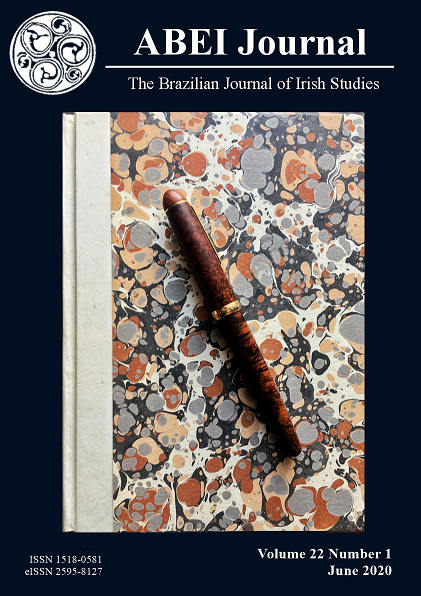The Poetics of “Pure Invention”: John Banville’s Ghosts
DOI:
https://doi.org/10.37389/abei.v22i1.3851Keywords:
Ghosts, Pure invention, Paintings, Intertext, Narrative, VaublinAbstract
This essay argues that John Banville’s Ghosts (1993) may in fact be Banville’s most technically inventive novel, replete as it is with multi-layered ontological levels that repeatedly bring its primary diegetic discourse into communion with other artistic forms – music, paintings, statues, as well as a narrative saturation with other literary antecedents that exceeds anything found elsewhere in his work. Ghosts demonstrates an implicit layering of dialectical levels, in effect a narrative enactment of the multiple worlds theory that so fascinates several of Banville’s narrators. Nowhere else does he generate so comprehensive a model of a multi-level ontological system in which the levels intersect so purposefully as Ghosts. This essay maps out a topography of what is effectively a sophisticated fictional variant on the scientific multiple worlds theory in Ghosts, and offers some perspectives on the significance of this aesthetic model.
References
Banville, John. “A True Picture of Picasso,” Irish Times, January 4, 2014, http://www.irishtimes.com/culture/books/a-true-picture-of-picasso-1.1642473 (accessed June 1st, 2020).
Bryson, Norman. Word and Image: French Painting of the Ancien Régime. Cambridge: Cambridge University Press, 1981.
heeke, Stephen. Writing for Art: The Aesthetics of Ekphrasis. Manchester: Manchester University Press, 2008
Hertel, Ralf. “The eye in the text: John Banville’s Frames (1989-1995)”. Making Sense: Sense Perception in the British Novel of the 1980s and 1990s. Amsterdam/New York: Rodopi, 2005.
Kenny, John. John Banville. Dublin: Irish Academic Press, 2009.
________. “Well Said Well Seen: The Pictorial Paradigm in John Banville's Fiction.” Irish University Review, Vol. 36, No. 1, Special Issue: John Banville (Spring - Summer,2006)
Lessing, G.E. Selected Prose Works of G.E. Lessing. Ed. Edward Bell, trans. E.C. Beasley and Helen Zimmern. London: G. Bell, 1879.
McHale, Brian. Postmodernist Fiction. London: Routledge, 1996.
McKeon, Belinda. “John Banville: The Art of Fiction No. 200,” The Paris Review, no. 188, Spring 2009, http://www.theparisreview.org/interviews/5907/the-art-of-fiction-no-200–john-banville (accessed June 2, 2020)
Meany, Helen. “Master of Paradox: Interview with John Banville.” The Irish Times (March 24, 1993): 12.
O’Connell, Mark. John Banville’s Narcissistic Fictions. London: Palgrave Macmillan, 2013.
______. “The Empathic Paradox: Third-Person Narration in John Banville’s First-Person Narratives” in Orbis Litterarum 66:6, (2011).
Schwall, Hedwig. “An Iridescent Surplus of Style: Features of The Fantastic in Banville's The Infinities”. Nordic Irish Studies, Vol. 9 (2010).
______. “An Interview with John Banville,” European English Messenger 6, no. 1 (1997).
Smith, Eoghan. “It’s That Man Again,” Dublin Review of Books, no. 83 (November 2019).
Steiner, George. Grammars of Creation, London: Faber & Faber, 2001.
Timmerman, Michelle B. “15 Questions with John Banville.” Interview. The Harvard Crimson, February 26, 2010, http://www.thecrimson.com/article/2010/2/26/fm-jb-think-work/ (accessed 31 Oct, 2019).
Wallace, Arminta. “‘I’m at Last Beginning to Learn How to Write, and I Can Let the Writing Mind Dream,’” in The Irish Times, June 30, 2012, http://www.irishtimes.com/culture/books/i-m-at-last-beginning-to-learn-how-to-write-and-i-can-let-the -writing-mind-dream-1.1069902 (accessed May 28, 2020).
Weretka, John. “The Guitar, the Musette and Meaning in the fêtes galantes of Watteau,” EMAJ: Electronic Melbourne Art Journal, no.3 (2008): https://emajartjournal.files.wordpress.com/2012/08/weretka.pdf (date accessed 23 April 2016).
Downloads
Published
Issue
Section
License
Copyright (c) 2020 Neil Murphy

This work is licensed under a Creative Commons Attribution-NonCommercial 4.0 International License.


